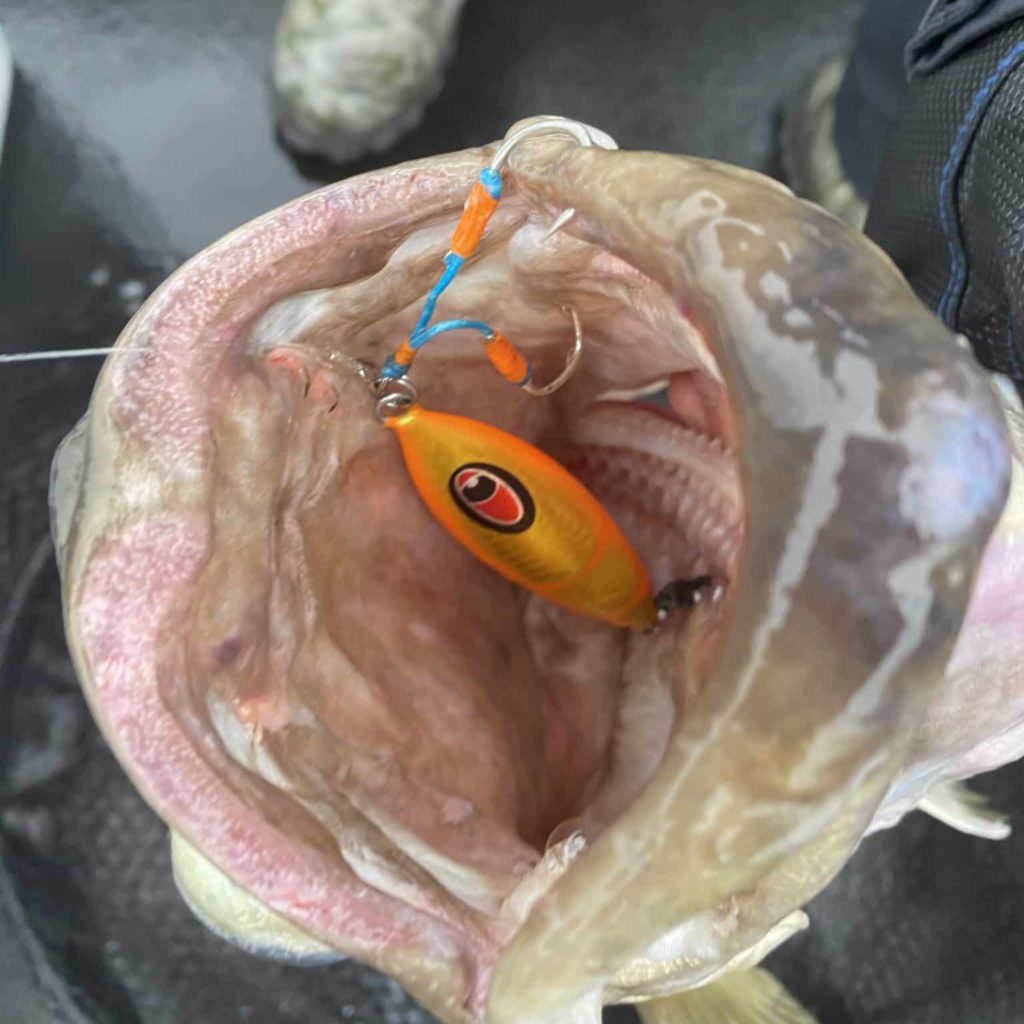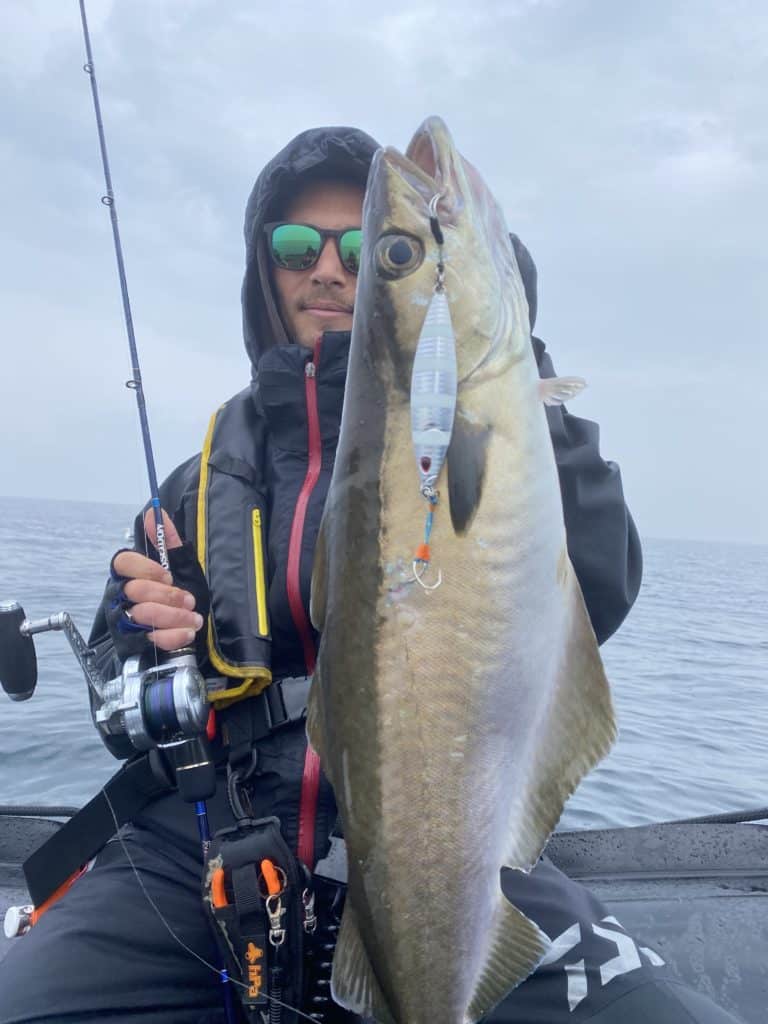As its name suggests, slow jigging is a slower technique than traditional jigging, requiring less effort and using lighter tackle.
The advantage of this technique lies in its versatility, making it possible to target a large number of fish species, at different depths and in most conditions. When used correctly, it can be a formidable tool, particularly when fish activity is low or when you are approaching areas subject to heavy fishing pressure.
The use of asymmetrically shaped Jigs, with more flicker than traditional Jigs and combined with minimalist animations perfectly vertical to the boat, will allow us to work longer and more efficiently on a restricted area. This will often have the effect of triggering hits where other techniques have failed. The main idea of this technique is to really become aware of the movements of the Jig through the water column as a function of drift and depth.
From there, the possibilities for the angler are numerous: you can vary the weight, the shape of the jig and the animation until you find the right combination that will make the fish react. It’s this constant search that makes fishing so complex and interesting.
From Japan to Brittany
To be able to practice this technique, which comes to us from Japan, in the rules of the art, we need to use a Bait-Casting set which will allow us to work the fish with the reel only. The very parabolic action of this rod is used solely for jig animation and striking.
With the basics of the technique out of the way, this article gives you a summary of what has worked for me and my trainees over the years, more specifically in the coastal areas of Brittany. I won’t go into other sectors in this article. It can be used as a basis for beginners who want to get started, or as a refresher for trainees who have come to learn on the job. It does not apply to other playing fields, but provides feedback on a given area.
Slow jigging encompasses three disciplines (the word pitch refers to the action of animating the jig):
- the high pitch
- the long fall
- the slow pitch.
They can be translated as: high animation, long descent, and slow animation.

It’s the latter that we’re interested in first, as it’s the most suited to our Breton waters and our fish species. That’s something I’ve come to realise after several years of practice in the Finistère area, and that’s just me. Once again, it’s up to you to adapt the technique to suit your fishing experience and sector. There’s no shortage of documentation on the subject, but it’s often too detailed and indigestible for the novice angler.
For the slow pitch, the animation is obtained by the action of the reel synchronised with the movement of the rod. A series of short pulls of 10 to 20 cm executed at a slow pace combined with the retrieve of the reel at a rate of 1/2 to 1/8 of a turn of the crank per animation constitutes the basis of the “slow pitch” animation, it’s up to you to vary until you find the winning animation of the day.
Thanks to the very progressive action of the rod and the centre of gravity of the Jig, which is positioned at different points depending on the model, the Jig will rise vertically during the animation phase before slowly dropping back down as it flutters. To achieve this effect, the angler will have to accompany the line during the descent phase while maintaining a slight tension. This is where 70 per cent of the bites occur and it is this very special action that allows the Jig to fish longer and therefore increase the chances of a fish becoming interested in it.
This will allow us to work the Jig methodically in stages through the water column where the species we are looking for is supposed to be held. It will be interesting to prospect in 5 to 10 metre stages to find the depth at which the fish are held. Here again, the use of a high-performance echo sounder will save time.
Specific equipment
We’re now going to take a look at the slow jigging equipment suitable for inshore fishing in Brittany, which will enable us to fish at depths ranging from 20 to 100 metres on average.

We use specific “slow jigging” rods, usually between 1m80 and 1m90 in length. The most versatile power is 50-150g for the mains. Depending on the area and the current, Jigs weighing more than 200 grams can be used in certain situations, in which case the power of the rod should be adapted.
The reel: it’s best to go for a reel with a round profile dedicated to this purpose. It should be strong enough to support the weight of the Jigs and have a good capacity. Sizes vary from brand to brand. My preference is for reels without line guides, as they allow the line to be reeled in properly and eliminate the ‘line rubbing’ factor on the line guide roller. This is a non-negligible advantage that will maximise the resistance of the line. The reel must be capable of returning at least 90 cm per turn of the crank.
For the braid, we prefer a graduated braid (multicoloured braid), to know the depth at which we will move the Jig. We’ll also opt for a braid with the smallest possible diameter (PE1 to PE1.5 as a general rule) because it will generate less resistance in the water and allow us to fish vertically, which is essential for slow-pitch fishing.
For the leader, use fluorocarbon at a length of 4 to 8 m. The sizes I use most are 16, 20 and 25 LB.
Choose a few jigs of different profiles and sizes with varying degrees of glide (jig shapes vary greatly from brand to brand), and in a range of weights to cater for all situations. The rule of thumb is to double the weight according to the fishing depth. In 40 metres of water, start by using an 80-gram Jig before adapting the weight according to the result obtained, bearing in mind the verticality of the line. The ideal way to start is to go from 20 g to 20 g to make an initial selection of Jigs: 60 g, 80 g, 100 g, 120 g, 140 g, 160 g.
As far as hooks are concerned, Jigs should be fitted with Assits Hook (two single hooks connected by a braid which is attached to the Jig by means of a broken ring), which unlike treble hooks will not restrict the lure’s swimming action and will accentuate the action of the Jig. The hooks should be relatively thin to compensate for the lack of rigidity of the rods due to their very parabolic action and to ensure good penetration of the hook during the striking action.

I recommend starting with a single set of Assists Hook at the head of the Jig to limit snags on the bottom and the loss of lures. If you find that you’re having a few misfires on the hook, you can then add a second set of Assists at the rear of the Jig. Note that for best efficiency the hooks should meet in the centre of the Jig without overlapping (this will give you an idea of how long your Assists should be depending on the Jigs used).
To get the best possible action, the slow jigs must be connected to the line by a fixed point. Swivels should be avoided, and a combination of a broken ring and a welded ring should be used so that you can change the jig quickly to suit the conditions.
An article detailing the animation phases and movements of the different types of Jigs will follow.

